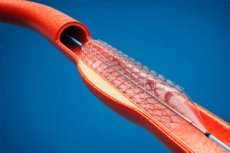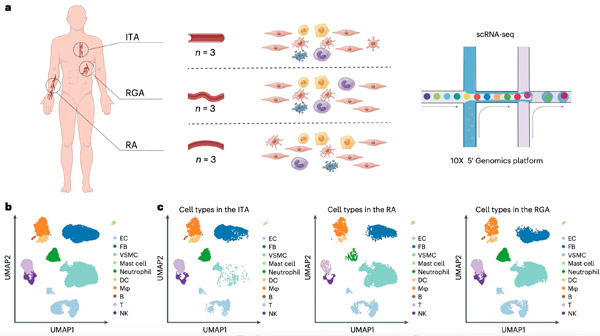
18 May 2024, 07:56
冠状动脉搭桥术(CABG) 是一种外科手术,可以改善心脏组织的血流,有效治疗冠状动脉疾病引起的心肌缺血。在 CABG 手术中,医生会从患者体内取出一条健康的血管,并将其连接到病变的动脉,使血液能够绕过冠状动脉的阻塞部分。
用于CABG手术的主要健康血管包括乳内动脉(ITA)、桡动脉(RA)和右胃网膜动脉(RGA)。在这些供体动脉中,ITA的远期疗效最佳,而RA和RGA易发生内膜增生、动脉粥样硬化和血管痉挛。
中国科学院遗传与发育生物学研究所(IGDB)王秀杰团队与中国医学科学院阜外医院宋建平团队合作,利用单核RNA测序(scRNA-seq)研究了ITA、RA和RGA的细胞类型组成和基因表达谱。

对从三种供体动脉中分离的38,814个单细胞进行分析。a. 总体研究设计示意图;b. 汇总供体动脉数据集的UMAP图,细胞根据主要细胞类型着色;c. UMAP图显示每种供体动脉中主要细胞类型的组成和相似性。资料来源:IGDB
研究人员发现,这三类供体动脉在吸收脂质颗粒的能力、血流动力学、血管痉挛和纤维化方面存在差异。结合人细胞和小鼠的实验验证,提出了以下四种针对CABG的优化策略:抑制巨噬细胞移动因子可减轻RA的内膜增生;钾通道激活剂可对抗对钙拮抗剂无反应的RGA的血管痉挛;抑制CREB5和GDF10可减少RA和RGA的细胞外基质沉积和纤维化;PCSK9抑制剂推荐用于ITA的调脂治疗。
本研究有望为CABG临床策略的制定以及术后药物的选择提供指导。
这篇题为“在单细胞水平上优化动脉移植的策略”的论文发表在《自然心血管研究》杂志上。

